Conrad von Rappard, 1805 - 1881
August Menzel and Company, 1850 - 1851
and Engell and Company, 1851 - ca. 1865
distributed by Schäffer and Budenberg
by Brian Stevenson
last updated November, 2019
Depending upon one’s views, Conrad von Rappard was an escaped felon or a
political refugee through the mid-1800s. During that time, he completed a Ph.D.
on studies of synapta (sea cucumbers) in Paris, and operated a microscope- and
slide-making business in Wabern, Switzerland. Being without legal documentation
in Switzerland, von Rappard first named his business after partner and noted
biologist August Menzel, then after his wife-to-be Augustine Engell.
Karlheinz
Rosenbauer, in his Mikroskopische
Präparate, identified von Rappard’s slides. They were covered in black paper
with gold patterns (Figures 1 and 2). The slides were generally issued in
groups of 24 to 100, and were prepared with numbered circular labels. von
Rappard distributed his slides to France, England, Netherlands and probably
other international markets, so numbering the slides was more efficient than
producing written labels in multiple languages. Each slide series was
accompanied with a booklet describing the specimens. These slides are often
found today with various handwritten labels, placed there by owners who did not
want to continually refer to the manufacturer’s list (Figure 1C). The mounted specimens
changed between series changed, probably due to inconsistency of supplies to
Wabern. Three different specimen lists, from 1851 through 1854, are illustrated
in Figure 11.
In
addition, von Rappard produced microscopes (Figures 4-6). A handheld instrument
designed for passing around a classroom or salon proved to be very popular
(Figures 5-6). Paul Waechter, of Berlin, continued to produce that pattern of
microscope into the 20th century (Figures 7-9).
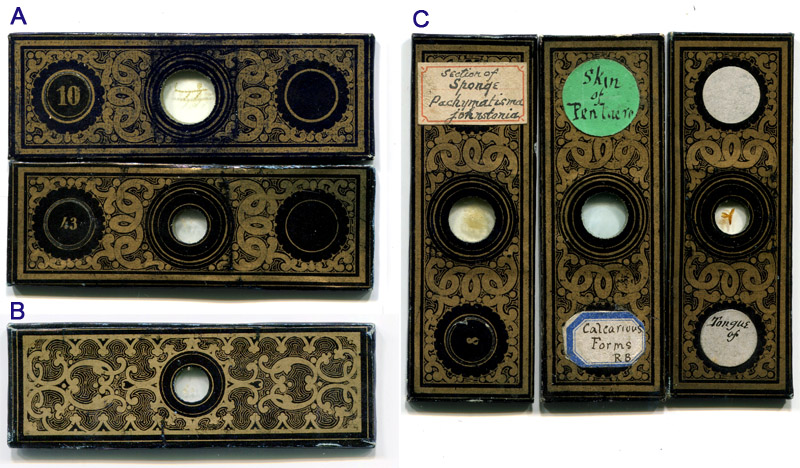
Figure 1.
Microscope slides produced by
Conrad von Rappard, as Menzel & Co. or Engell & Co. All are standard
1x3 inch (27 x 77mm).
(A) Front
views. The numbers were attached as circular labels, allowing mass production
of the patterned wrapping papers. Unnumbered slides are often encountered,
probably due to loss of the gummed number labels.
(B) A different, complementary pattern was applied to the slides’
reverse. The edges are covered in plain black paper.
(C) Examples of von Rappard slides on which purchasers applied
their own descriptive labels. That fact accounts for the wide variety of label
and handwriting styles that can be found on these slides.
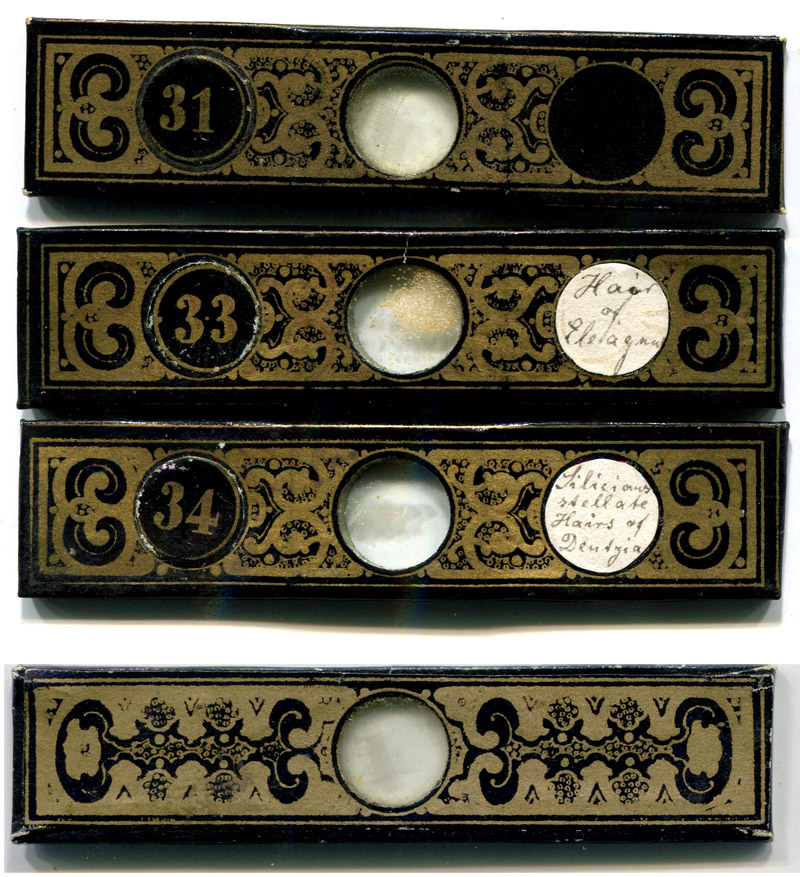
Figure 2.
Smaller slides (5/8 x 2 5/8 inch
/ 16 x 67 mm) by von Rappard/Menzel/Engell. The lower image shows the pattern
of the back paper.
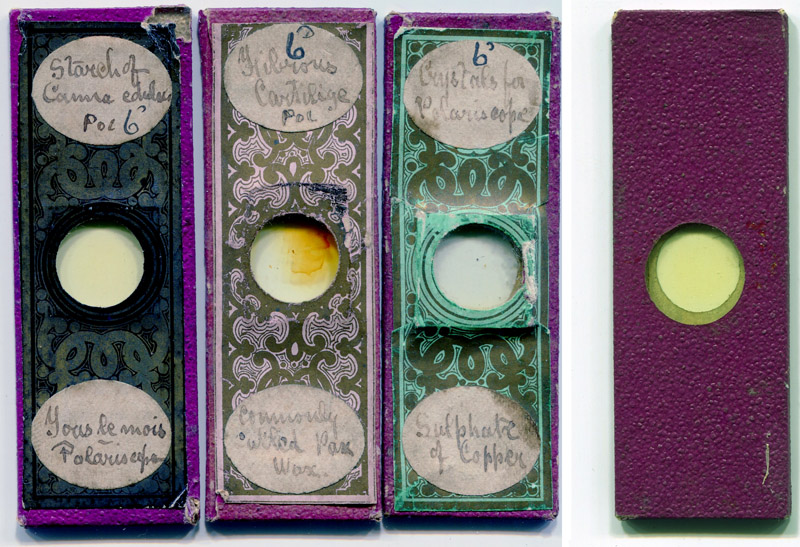
Figure 3.
Three standard (1x3 inch) slides
with differently-colored variations on the von Rappard/Menzel/Engell paper
pattern. The black and the green papers have the same pattern as on the front
of the gilt-on-black slides, and the middle, pink slide has the same pattern as
seen on the reverse of the gilt-on-black slides. In that von Rappard produced
his slides in Wabern, Switzerland, it is reasonable to assume that the papers
on these slides also came from that location and that they were, therefore, produced
by von Rappard. It is not apparent whether these were produced in a series or
for individual sales. The handwritten labels are in English, and so may have
been applied by a purchaser. The reverse and edges of the slides are covered
with a single sheet of textured purple paper. All three contain specimens for
viewing through crossed polarizing filters (polariscope).
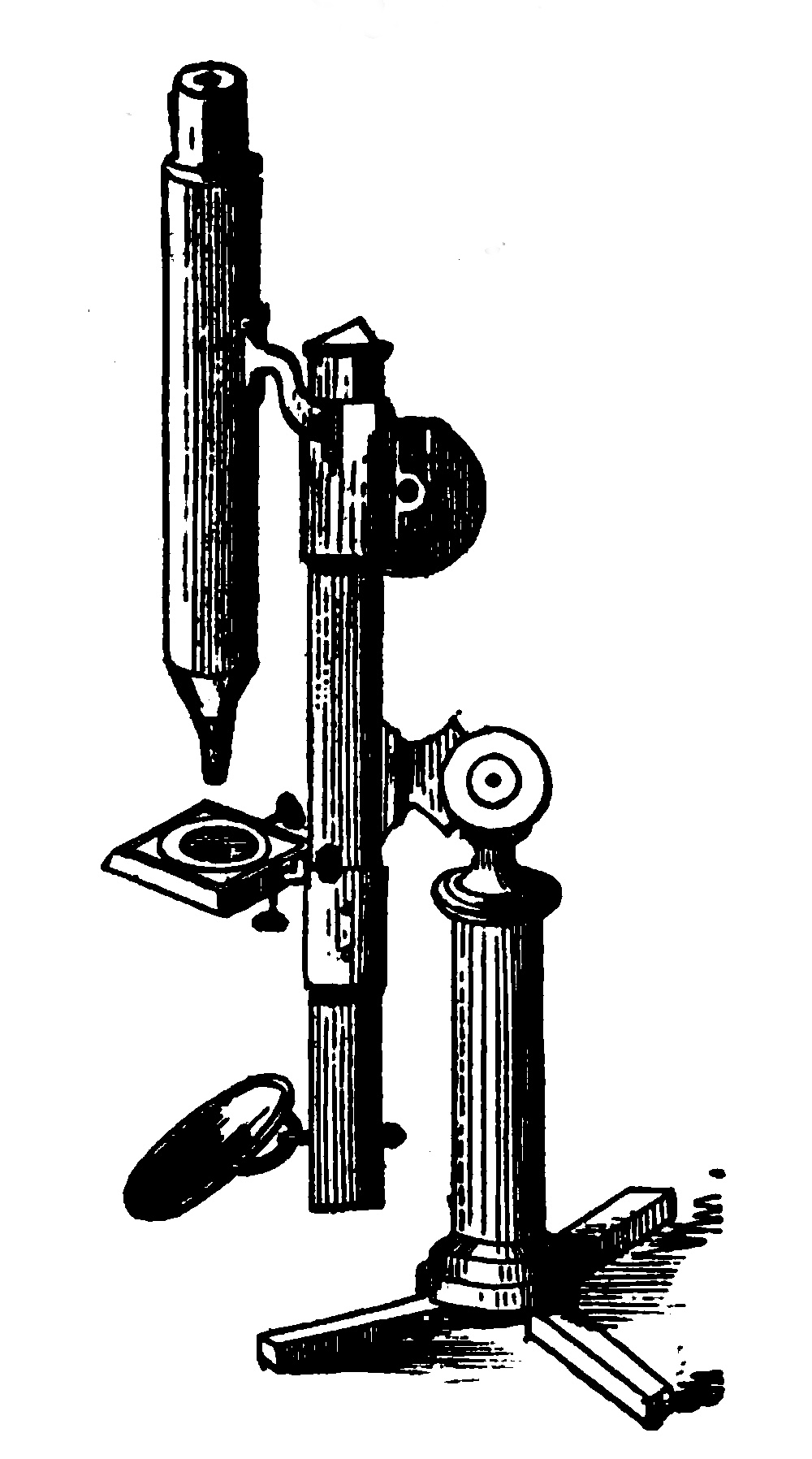
Figure 4.
An early model microscope by Engell & Co. Engraving from ‘Illustrirtes Lexikon der Gesammten Wirtschaftskunde’, 1854.
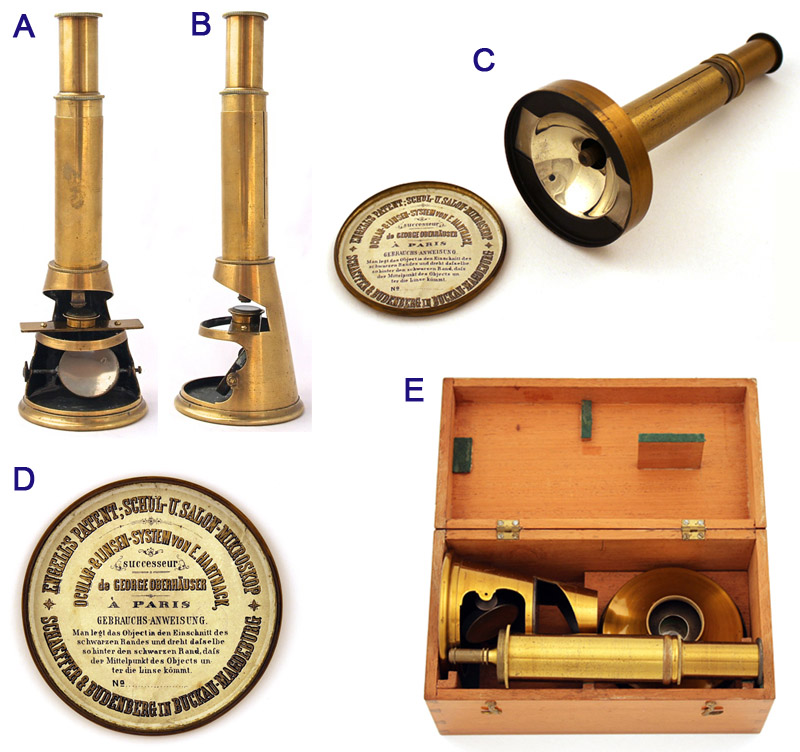
Figure 5.
Views of surviving School and Salon
Microscopes, by Engell and Co.
(A and B) Set up as a table-top, drum-style microscope.
(C) Set up with a base that firmly held a slide and permitted
numerous people to view the same object by passing from hand-to-hand (see
Figure 6).
(D) Cover for the base shown in panel C. The description notes that lenses were produced by Hartnack, in Paris.
(E) All parts fit into a wooden carrying case.
Paul Waechter, of Berlin, later modified the focusing mechanism, and
sold such microscopes into the 20th century (see Figures 7-9).
Photographs generously provided by Drs. Guillermo Crovetto Montoya and Timo Mappes. These and other instruments in their collections may be seen at
https://sites.google.com/site/coleccionguillermocrovetto/home/alemanes/microscopio-de-tambor-con-base-tronco-cnica and
http://www.musoptin.com/engell_patent.html.
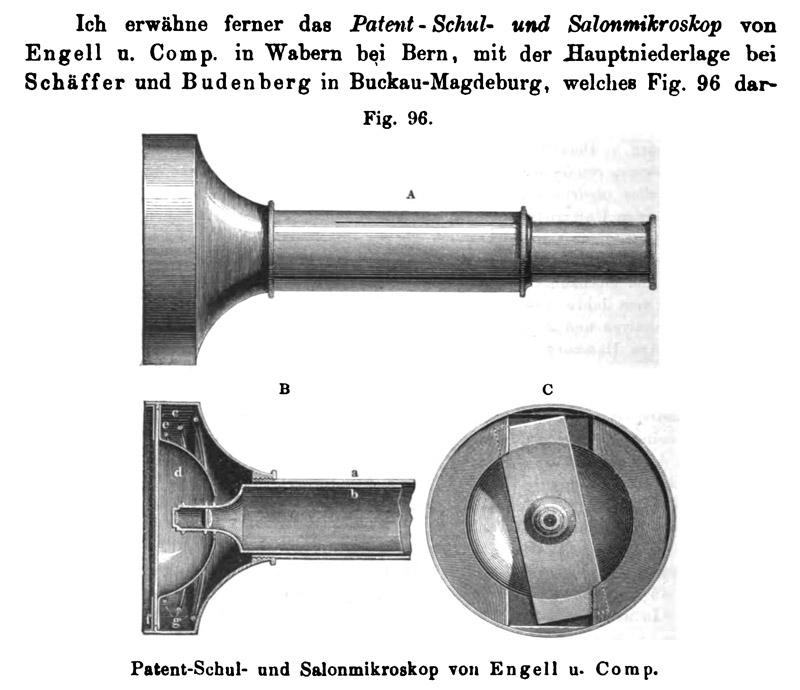
Figure 6.
Engravings of the Engel & Co. “School and Salon Microscope”, with the slide-holder attachment that allows the instrument to be focused, then passed from person-to-person. From ‘Das Mikroskop’, by Pieter Harting, 1866.
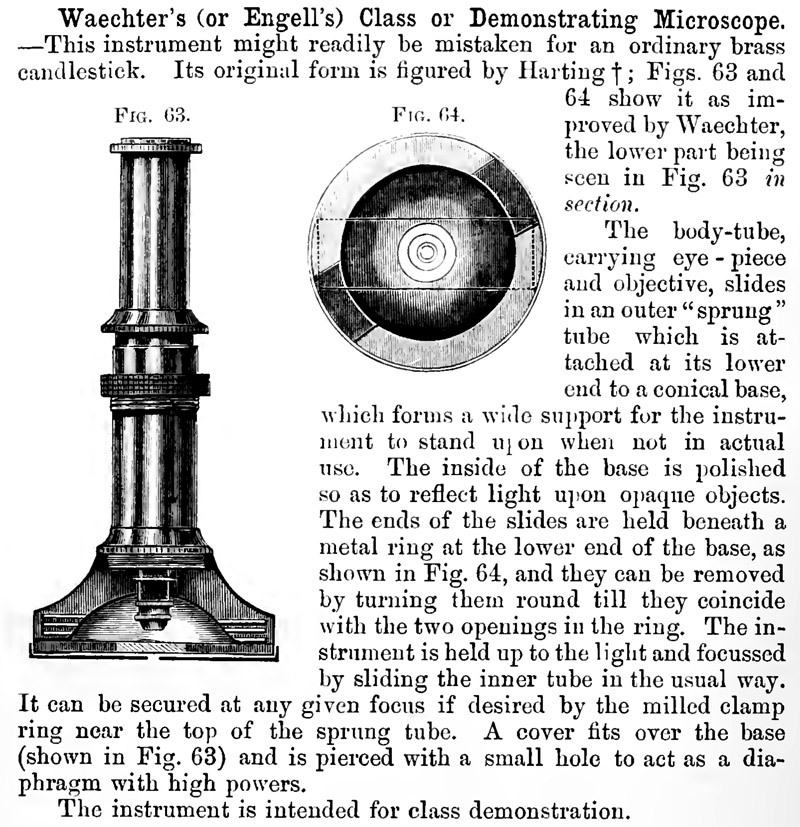
Figure 7.
From an 1882 issue of ‘The Journal of the Royal Microscopical Society’. Paul Waechter appears to have acquired von Rappard’s patent for this microscope. Waechter improved the focusing mechanism. His firm was still producing this instrument in 1906.
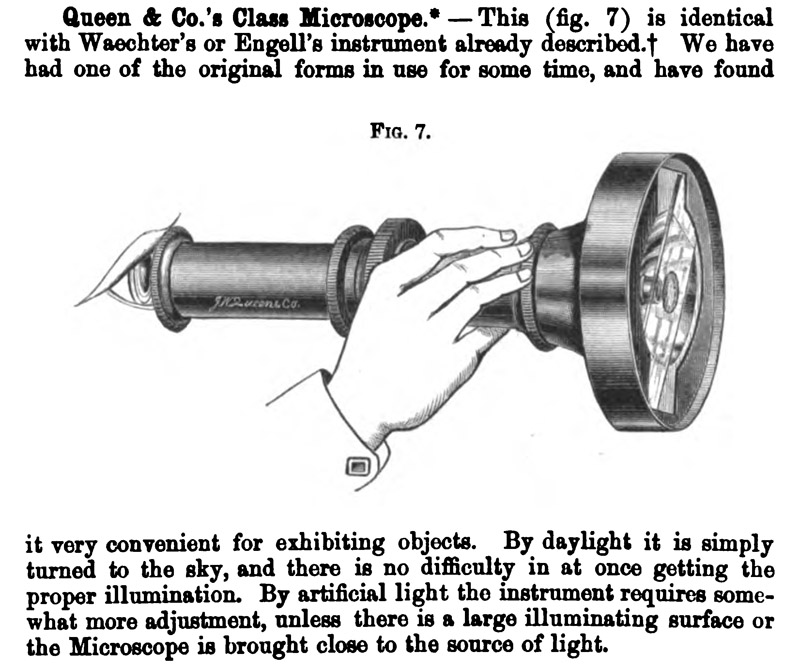
Figure 8.
From an 1885 issue of ‘The
Journal of the Royal Microscopical Society’. The U.S. firm of Queen and Co.
imported many of their instruments, so it is very likely that their “Class
Microscope” was manufactured by Waechter.
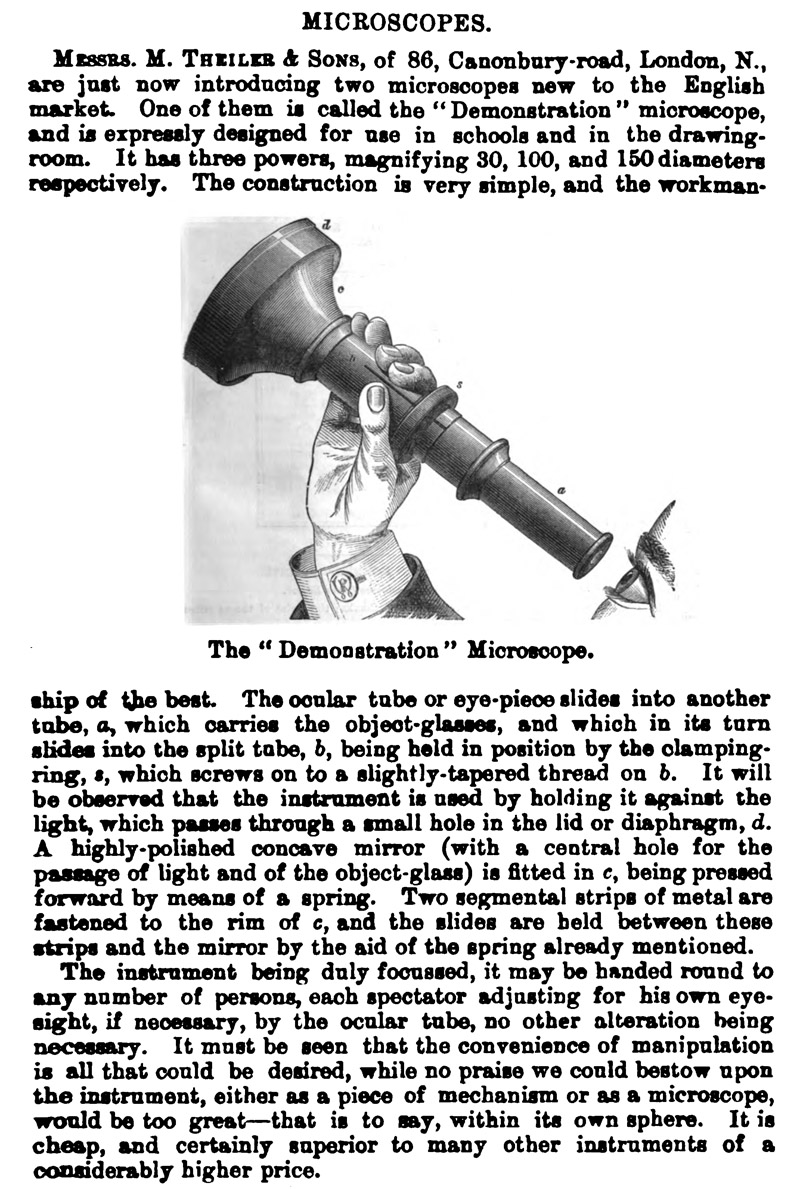
Figure 9.
From an 1885 issue of ‘Knowledge’. A 1906 advertisement for Waechter’s version of the instrument used the same engraved picture, suggesting that Waechter supplied this instrument to Theiler & Sons.
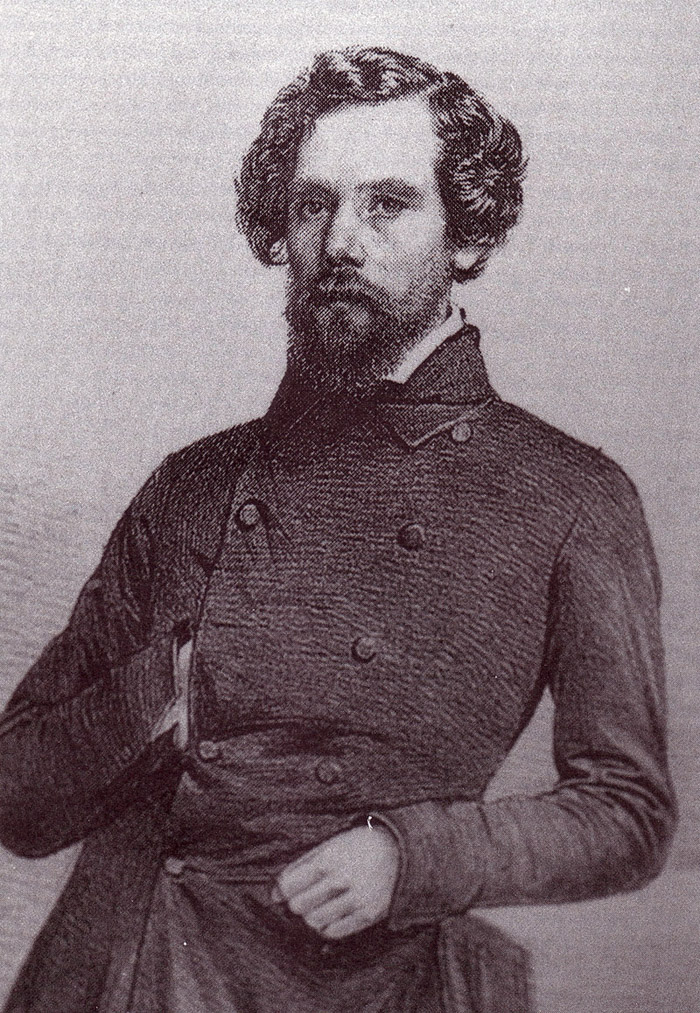
Figure 10.
Undated engraving of Conrad von Rappard in mid-life.
Conrad (Konrad) von Rappard was born August 19, 1805 in Unna,
Westphalia, Prussia. His father, Konrad Gerhard von Rappard, was an officer of
the Court in Potsdam. His grandfather, Johann Konrad von Rappard, was a Royal
Commissioner and operator of salt mines and brine works.
Young Conrad studied law between 1823 until 1827 in Berlin, Bonn, Halle,
Jena and Heidelberg. He was a member of the Corps Wesfalia fraternity, where
participation in mensur-style fencing gave him the facial scars (Schmiss)
expected of an educated aristocrat on the rise.
After law school, von Rappard served as a judge in Potsdam, Zehdenick,
Poznan and Altlandsberg. He held a judgeship in Altlandsberg until 1842.
In 1838, Conrad married Franziska Richter. They had at least 3 children
over the next 11 years.
Likely influenced by his family’s history in mining, in 1842 von Rappard led
a consortium to establish coal mines in Brandenburg. A series of mines
apparently turned a good profit. In 1850, he purchased the farms and manor of
Glambeck.
von Rappard was elected to the Frankfurt National Assembly in 1848. There, von Rappard became involved with many
liberal, democracy-inclined politicians. He was part of the 1849 commission
that offered Prussian Kaiser Friedrich Wilhelm IV the Crown of all Germany. The
King refused, insisting that such a crown could only be offered by the Princes
of the Germanic states, not by commoners. Following the dissolution of the
Frankfurt Assembly in May, 1849, and subsequent rebellions, an arrest warrant
was issued for Conrad von Rappard. Forewarned, von Rappard escaped to London.
He was tried in absentia, and sentenced to imprisonment.
From London, von Rappard moved to Paris, then Zürich and Wabern,
Switzerland. He had signed over his property in Germany to his wife before
fleeing. Franziska refused to have anything to do with her fugitive husband,
and the couple eventually divorced in 1854. von Rappard’s business partners in Brandenburg
were also unwilling to continue associating with him.
In Switzerland, von Rappard made business ventures in mining, hotels and
microscopy, the latter a reflection of his growing interest in biology. The
Microscopical Institute of August Menzel and Co. was established in Wabern in
1850. The term “microscopical institute” (mikroskopische institut) came to be
used by many Germanic microscopists, and meant “microscopy business”, not an institute
of higher education. August Menzel and Co. was the first such business in
Switzerland. Menzel probably managed the day-to-day operations of the business,
as von Rappard was apparently away for much of the next 1-2 years. In 1852, he received
a Ph.D. in Paris on studies of synaptae. His research included excursions along
the coasts of France, Italy, Holland and England. von Rappard’s interest in
marine biology probably accounts for his microscope slides’ emphasis on such
animals. Relative to Menzel in Switzerland, von Rappard would have had easier
access to sea life during his studies, and was probably the producer of
many/most of the company’s slides.
Coinciding with the end of his doctoral studies, von Rappard renamed the
business as Engell and Co. in early 1852. Clearly, von Rappard had a strong
relationship with Augustine Engell for many years before their marriage. That
event took place in June, 1856. Their daughter, Clara, became a noted artist. Her
paintings of Conrad and Augustine appear at the end of this essay.
Initial offerings of the microscopy business were series of slides
(Figures 1-2 and 11). Microscopes were produced by 1854 (Figure 4). The popular
school, salon or demonstrating microscope employed lenses produced by Hartnack
in Paris. Presumably, von Rappard or employees crafted the microscopes’
brasswork. As early as 1851, von Rappard contracted with the industrial valve
company of Schäffer and Budenberg to distribute his microscopes and slides
throughout Europe. Based in Magdeburg, Germany, Schäffer and Budenberg opened a
branch in Manchester, England in 1853, and had other branches in Paris, Lille, London, Glasgow, New York, Milan, Zürich, and Hamburg.
Due to failing eyesight, von Rappard gave up the business of microscope slide-making in
the mid-1860s. He then devoted the remaining years of his life to developing
tourism in the Interlaken region of Switzerland. He was granted a pardon by Kaiser
Wilhelm I, in 1871, and briefly visited Germany again. Conrad von Rappard died at
his villa in Interlaken on January 8, 1881.
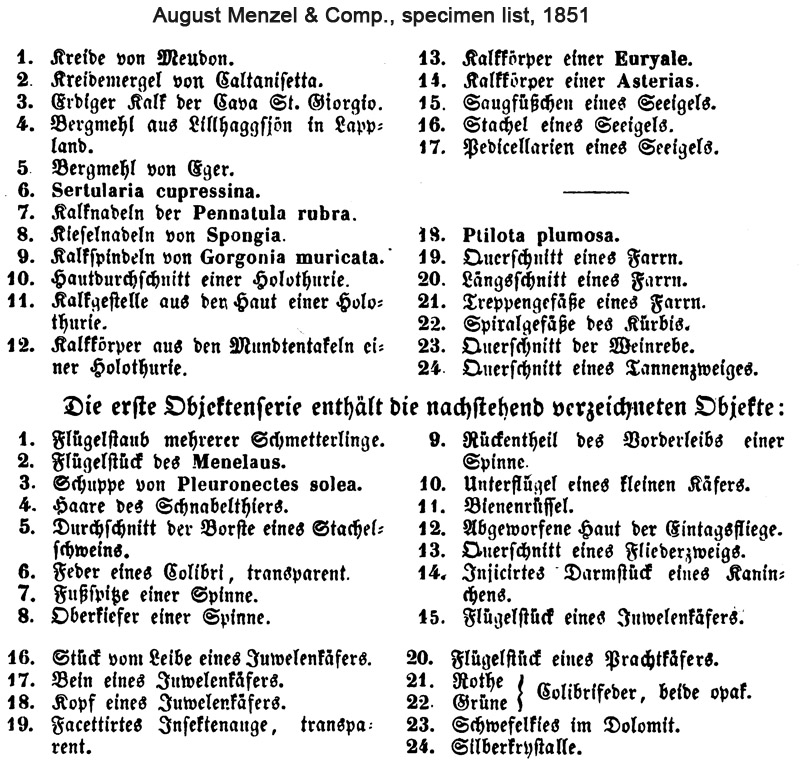
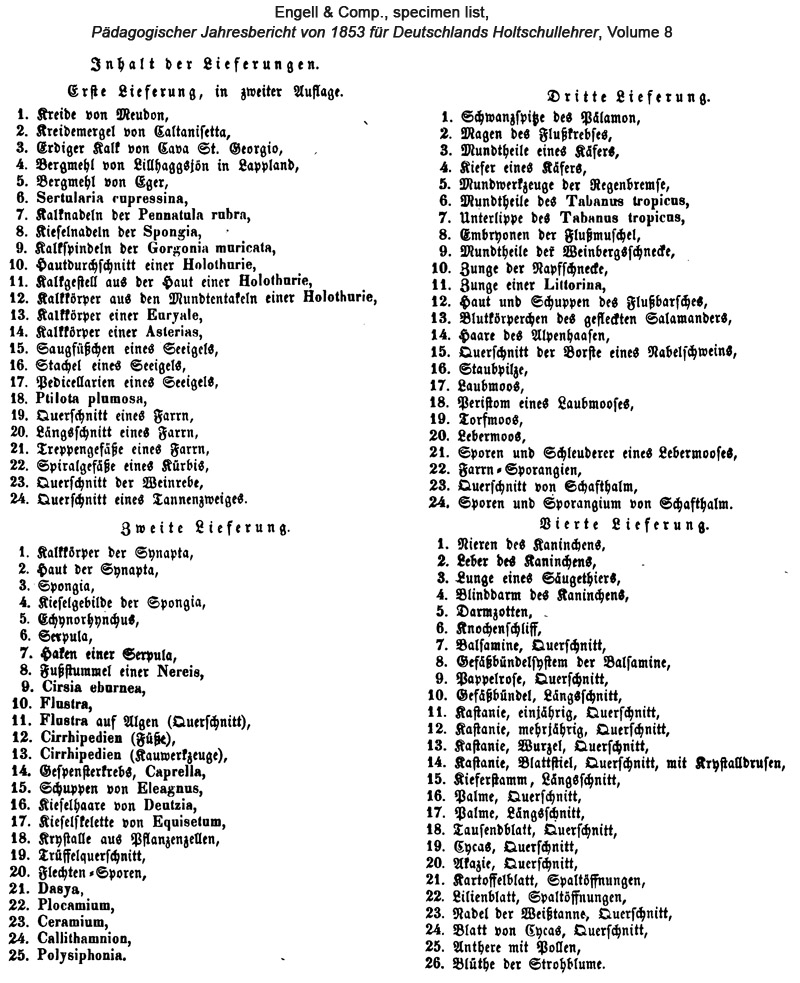
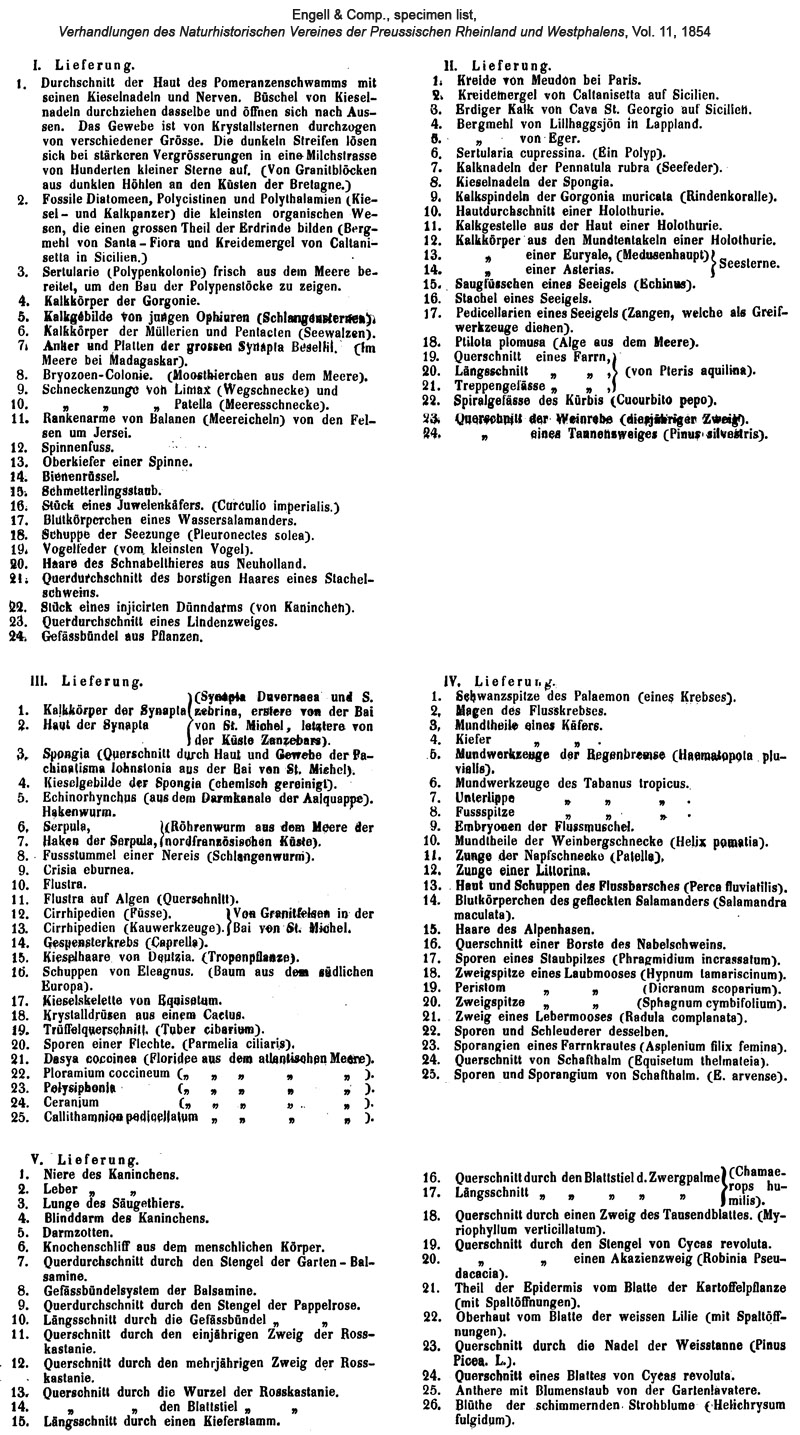
Figure 11.
Three early lists of specimens on microscope slides prepared by August Menzel & Co. and Engell & Co. Each list has different contents, probably due to varying access to specimens. The emphasis on marine life reflects von Rappard’s interest in oceanography.
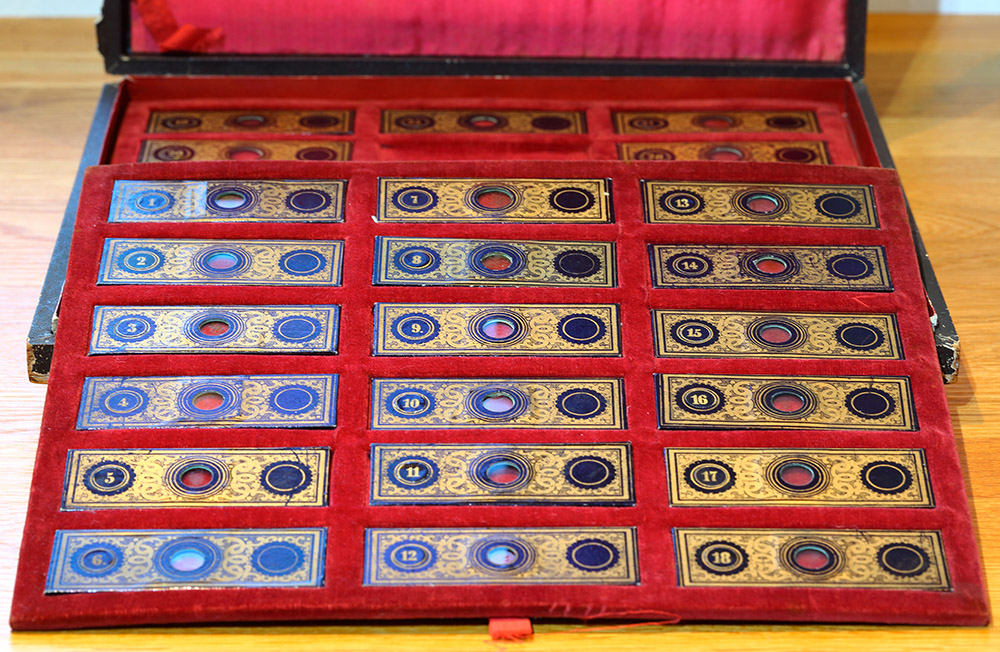
Figure 12.
A cased set of 32 slides by Engell & Co., retailed in England by Schäffer
& Budenberg. Courtesy of Sandra Pearce.
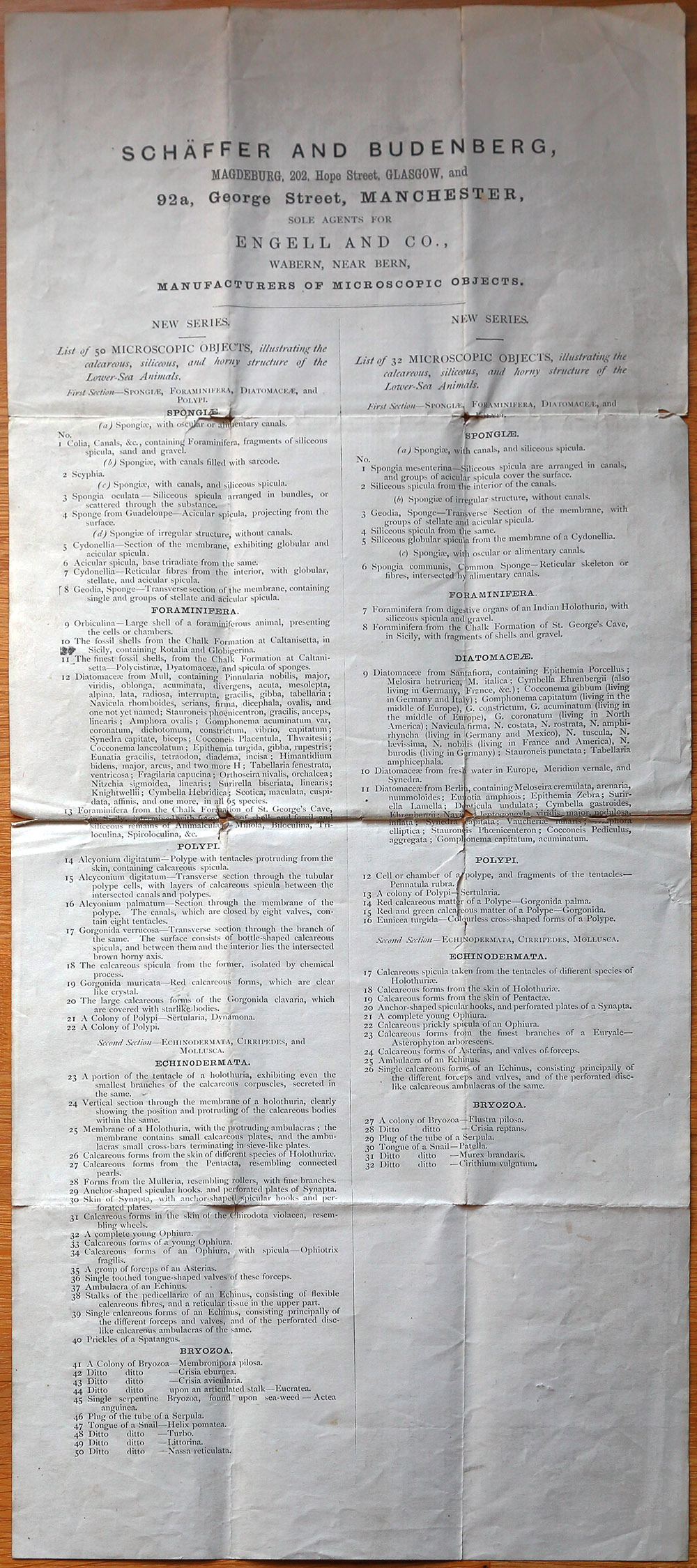
Figure 13.
English language list of specimens that accompanied the 32-slide set shown in Figure 12. The sheet also lists specimens in another 50-slide set. Courtesy of Sandra Pearce.
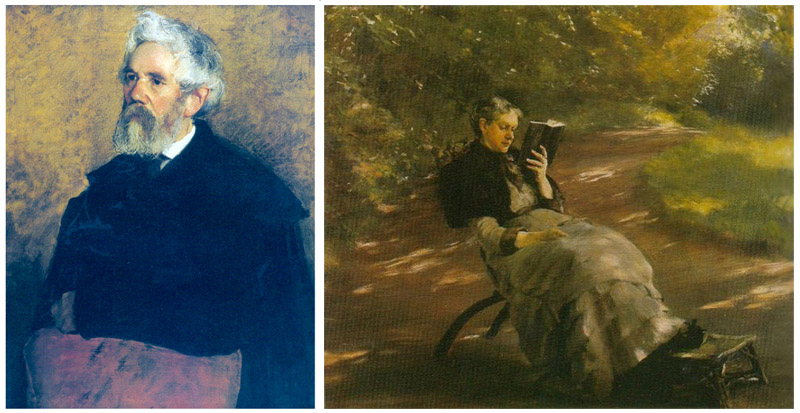
Figure 14.
Paintings of Conrad and Augustine Engell von Rappard, by their daughter, Clara von Rappard.
Acknowledgement
Many thanks to Sandra Pearce for sharing images of her slides and decriptive list, and Guillermo Crovetto Montoya and Timo Mappes for providing images of their Engell microscopes.
Resources
Archiv der Pharmacie (1852) Description
of August Menzel and Company, and distribution by Schäffer and Co., dated July,
1851, page 364
Aus der Natur Notice of microscope slides
prepared by Engell and Co., Vol. 21, pages 502-506
Baedeker, Karl (1863) “The Villa Fellenberg at Wabern contains the Microscopic Institution of Engell und Co.”, Switzerland, Williams and Norgate, London, page 122
Bibliotheca Zoologica: Verzeichniss der Schriften über Zoologie, Vol. 1 (1861) Dates and publishers of microscopical object lists from
August Menzel and Engell, page 15
Clara von Rappard (accessed November, 2013)
http://claravonrappard.ch/cms/die-kuenstlerin/galerie.html
Correspondenz-Blatt des Zoologisch-Mineralogischen Vereines (1856) Descriptions of slides by Engell and Co., Vol. 10, page 100
Frey, G.
(1852) Forward and specimen list from August Menzel, dated
December, 1851, Die Hartgebilde der
Niedersten, Franz Hante, Zürich
Harting, Pieter (1866) Description of the Engell and Co. School and Salon Microscope, Das Mikroskop, Vol. 3, pages 196-197
Henry Heil Chemical Co., Illustrated Catalogue and Price-list of Chemical
Apparatus (1906) Picture and price list for Waechter’s Demonstration
Microscope, page 321
Jahrbücher der in- und Ausländischen Gesammten
Medicin (1857) Notice of microscope slides prepared by Engell and Co., Vol.
93, page 144
Journal of the Royal Microscopical Society (1882) “Waechter’s (or Engell’s) Class or Demonstrating Microscope”, Series 2, Vol. 2, page 398
Journal of the Royal Microscopical Society (1885) “Queen and Co.’s Class Microscope”, Series 2, Vol. 5, page 119
Knowledge
(1885) Description and picture of Theiler and Sons’ Demonstration microscope, “new to the English market”, Vol. 7, page 491
Löbe, William (1854) Description and illustration of Engell
and Co. microscope, Illustrirtes Lexikon
der Gesammten Wirtschaftskunde, Vol. 3, O. Vigand, Leipzig, page 576
Mitteilungen der Schweizerischen Entomologischen
Gesellschaft (1880) Obituary for August Menzel, Vol. 5, pages 492-494
Monthly
Microscopical Journal (1869) Description of an
1855 French list of slides by Engell and Co., Vol. 1, pages 74-75
Natuurkundig Tijdschrift voor Nederlandsch-Indië (1856) Descriptions of slides by
Engell and Co., Vol. 11, pages 488-489
Official Catalogue, Exhibition of the German Empire (1900) Schäffer
& Budenberg, pages 162-163
Rade, Karl (1851) Descriptions of slides by August Menzel and Co., Pädagogischer Jahresbericht für Deutschlands Holtschullehrer, Vol. 5, F. Brandstetter, Leipzig, page 295
Rade, Karl (1854) Descriptions
of slides by Engell and Co., Pädagogischer Jahresbericht von 1853 für Deutschlands Holtschullehrer, Vol. 8, F. Brandstetter, Leipzig, pages 220-223
Regel, Eduard
(1865) “Das mikroskopische Institut von Engell & Comp, früher Menzel & Comp.”, Gartenflora
Deutschlands und der Schweiz, Vol. 14, Ferdinand Enke, Erlangen, page 94
Rosenbauer, Karlheinz A. (2003) Schäffer & Budenberg, in Mikroskopische Präparate, Vol. 1, pages 80-83
Verhandlungen des
Naturhistorischen Vereines der Preussischen Rheinland und Westphalens (1854) Descriptions of slides by Engell and Co., Volume 11, pages 33-37
Wille,
Klaus-Dieter (2004) Conrad von Rappard: Life stages of a Westphalia nobleman
between Brandenburg and Switzerland, translated into English from The Herold, Vol. 16, a.vonrappard@cox.net
Pictures of Engell and Wächter microscopes:
http://www.musoptin.com/engell_patent.html
http://www.musoptin.com/berliner_demo.html
https://sites.google.com/site/coleccionguillermocrovetto/home/alemanes/microscopio-de-tambor-con-base-tronco-cnica
http://www.antique-microscopes.com/photos/Waechter%27s%20_Class_Demonstrating%20_%20Microscope.htm















